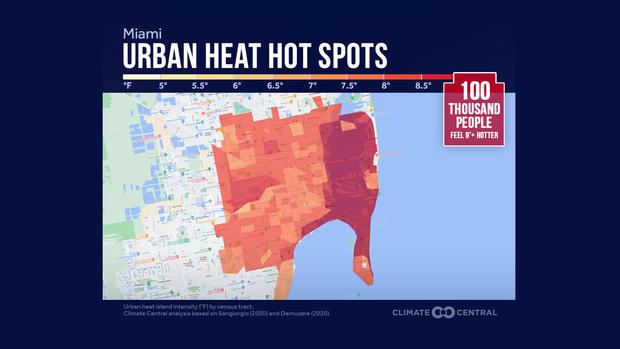Miami is third-hottest concrete jungle in US, report finds
MIAMI — The city of Miami is among the hottest concrete jungles in the United States, according to a recent report.
According to climate science nonprofit Climate Central, Miami has the third-worst "urban heat island effect" among 44 of the largest U.S. cities, which constituted for nearly a quarter of the total U.S. population. The nonprofit released their findings in their 2023 Urban Heat Hot Spots report on Wednesday.
The analysis calculated the urban heat island (UHI) index for each census tract within a city to estimate how much hotter these areas are due to the characteristics of the built environment, as cities with tall buildings and other large infrastructure built tightly together trap heat more than those that more sprawled out, according to Climate Central.
In their report, Climate Central found that Miami had the third-highest citywide average UHI index, just behind New York and San Francisco, respectively. Miami was also tied third with Chicago for highest population-weighed average UHI index.
To calculate their findings, Climate Central focused on three primary factors that influenced UHI index estimates: albedo, percentage of green space and population density. Out of all the factors, albedo — the proportion of incoming sunlight (solar radition) reflected by a surface — generally has the largest effect on UHI indexes, Climate Central stated.
Infrastructure such as roads, sidewalks, buildings and parking lots all have low albedo, meaning that they absorb more sunlight and radiate it back as heat into city. Additionally, bodies of water also have low albedo. According to Climate Central, Miami's coastal cityscape is what contributed to its high ranking.
As shown in Climate Central's heat map of the city, the albedo effect is the most intense in neighborhoods and areas such as Brickell or Downtown Miami, while more surburban and leafier places like Coral Gables and Pinecrest were much cooler.
Not only does Miami have a low albedo, the city is also dominated by a sprawling heat intensity -- meaning that the UHI index is not just concentrate in the city's core but rather spread across the developed land area.
Despite the devastating heat, Climate Control did offer some solutions to reduce the impact of the urban heat island effect. The nonprofit suggested that planting trees along streets and installing cool roofs and pavements are among ways to cool down cities.
A study published by scientists at the University of Miami and Florida International University in June found that Miamians may experience temperatures 6 degrees Fahrenheit hotter on average than what the National Weather Service officially reports, which can feel up to 11 degrees higher with humidity.





